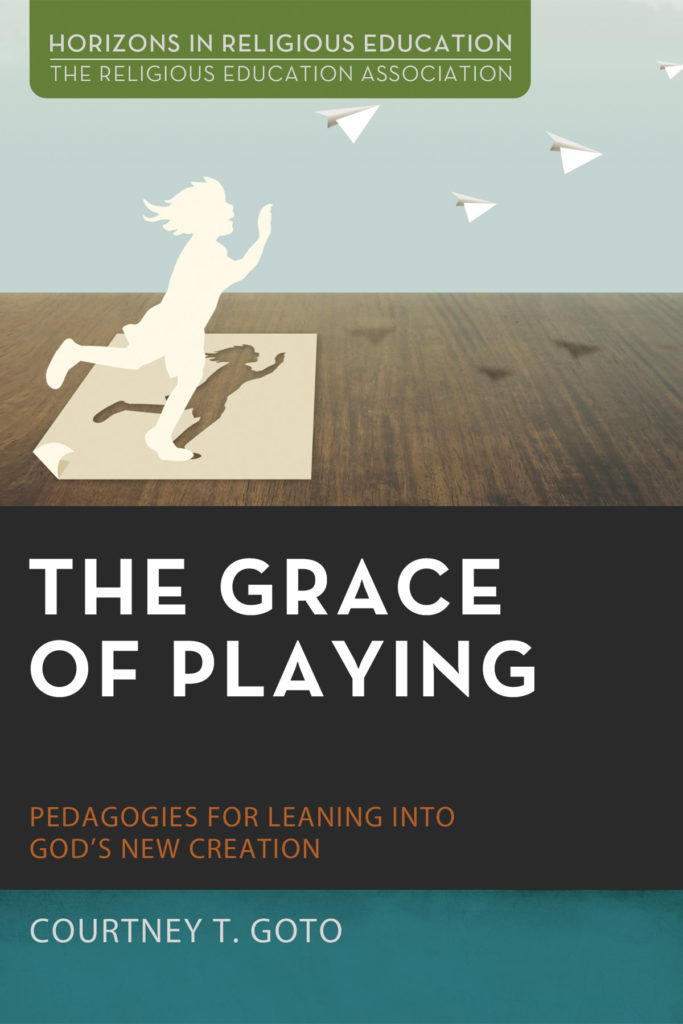Download PDF: RV Lavallee, The Grace of Playing
By Courtney T. Goto
Eugene, OR: Pickwick Publications, 2016. 150 pages. $22.00
In this short yet insightful text, religious education scholar Courtney Goto argues that “creating conditions for revelatory experiencing can be better understood in the light of playing,” and situates this thesis within an understanding that “playing provides insights into pedagogies in which learners are creating and are created anew” (12). Goto asserts that the language of playing provides creative and imaginative insight into the communal nature of revelation—as something that occurs between persons—and the transformative aims of religious education. To this end, the author engages a practical-theological examination of playing as a social-scientific, theological, historical, and aesthetic reality. As a contribution to the study and practice of religious education, the text provides a critical examination of revelatory experiencing in teaching and learning at the intersection of two contexts wherein playing is often unfortunately marginalized: the church and the academy.
Four central chapters of the text provide analytical perspectives of playing through which Goto develops a practical-theological analysis of playing and an inspiration for teaching generated through such analysis. In each chapter, Goto is careful to explore both the benefits and limitations of each perspective. The first of these chapters (chapter two) provides a social-scientific examination of playing, wherein the author relies on the psychological work of D.W. Winnicott in order to develop an understanding of playing as “losing and finding oneself in engaging reality and one another ‘as if,’ exploring freely a world of possibilities bounded by structure that facilitates relationship” (15). This definition of playing (particularly in terms of engaging reality and one another “as if”) grounds Goto’s theological, historical, and aesthetic analyses of playing as pedagogy for “leaning into God’s new creation.” Goto notes that “acting or believing ‘as if’ is vital for nurturing faith” (32) and “this ‘not-yet’ and ‘already’ dimension of revelatory experiences” (a dimension that appears in scriptural metaphors of the “kingdom of God” and God’s new creation) “are theological ways of referring to what acting or believing ‘as if’ is also attempting to describe in the language of playing” (33).
“Playing Theologically” (chapter three) explores this reality more deeply through a critical analysis and reconception of Jürgen Moltmann’s work, Theology of Play. Goto uses this analysis and reconception to shape a theological understanding of playing as a practice that provides “formative, aesthetic experience for Christian faith” (46).
“Playing Historically” (chapter four) describes two historical examples of revelatory experiencing through playing in community: the Christian tradition of the “holy fool” and the use of devotional dolls among Rheinland Catholic nuns in fourteenth century Germany. In this chapter, which provides psychoanalytic and theological perspectives on these practices, Goto concludes with insights for facilitating revelatory experiencing though playing.
Finally, of particular interest is the author’s development in chapter five of the concept of “local practical theological aesthetics” (LPTA), which she defines as “the sensibilities that guide a Christian community’s unique ‘style’ of relating form and theological content” (109), and which she explores through a liturgical art installation at Sacramento Japanese United Methodist Church called, The Garden Series. Goto notes that “a community’s aesthetic sensibilities are based on their experiences of being ‘taken in’ by God’s beauty, which combines the sublimity of God’s transcendence with the groundedness of God’s vulnerability in taking human form” (109). Understanding, engaging, and helping to shape local practical theological aesthetics provides a significant contribution to practical theology and religious education. As Goto notes, “the faithful do not know the good news simply because they have read or been told about it. They experience it in relating to others, knowing it in their bodies, with the senses, in heartfelt imaginings, and authentic exchanges that hit home” (128). This statement describes the heart of revelatory experiencing in loving community with others, and it highlights both the importance of playing and the local practical theological aesthetics that playing nurtures.
Good practical theology (like good religious education) engages processes of becoming rather than merely relating sociological or theological theories and religious doctrines. Goto’s text embodies a commitment to engaging processes of becoming through its consistent emphasis on active images (playing as opposed to play; revelatory experiencing as opposed to experiences). Goto is insightful in pointing out that “a drawback of play theology and theology of play is that they do not treat playing as something one does. This creates a strange disconnect from life experience” (38). Playing, teaching, learning, and leaning into God’s new creation are things that people do together in love. The present work offers readers a helpful entrance into understanding and engaging ways in which revelatory experiencing may be fostered and facilitated through playing and pedagogies of play.
Cover image used by permission of Wipf and Stock publishers. www.wipfandstock.com




